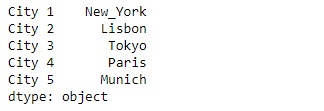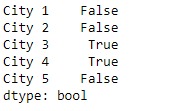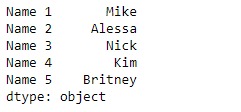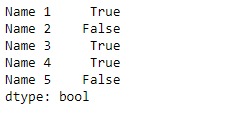Series.str可用於以字符串形式訪問係列的值並對其應用幾種方法。 Pandas Series.str.match()函數用於確定給定係列對象的基礎數據中的每個字符串是否與正則表達式匹配。
用法: Series.str.match(pat, case=True, flags=0, na=nan)
參數:
pat : 具有捕獲組的正則表達式模式。
case : 如果為True,則區分大小寫
flags : 一個re模塊標誌,例如re.IGNORECASE。
na : 默認NaN,填充缺失值的值
返回值:布爾值的序列/數組
示例1:采用Series.str.match()函數,以將傳遞的正則表達式與給定series對象的基礎數據中的字符串進行匹配。
# importing pandas as pd
import pandas as pd
# importing re for regular expressions
import re
# Creating the Series
sr = pd.Series(['New_York', 'Lisbon', 'Tokyo', 'Paris', 'Munich'])
# Creating the index
idx = ['City 1', 'City 2', 'City 3', 'City 4', 'City 5']
# set the index
sr.index = idx
# Print the series
print(sr)輸出:

現在我們將使用Series.str.match()函數,以將傳遞的正則表達式與給定series對象的基礎數據中的字符串進行匹配。
# match either 'Tokyo' or 'Paris'
result = sr.str.match(pat = '(Tokyo)|(Paris)')
# print the result
print(result)輸出:

正如我們在輸出中看到的,Series.str.match()函數已返回一係列布爾值。它包含了True對於那些成功匹配其他值的值False。
示例2:采用Series.str.match()函數,以將傳遞的正則表達式與給定series對象的基礎數據中的字符串進行匹配。
# importing pandas as pd
import pandas as pd
# importing re for regular expressions
import re
# Creating the Series
sr = pd.Series(['Mike', 'Alessa', 'Nick', 'Kim', 'Britney'])
# Creating the index
idx = ['Name 1', 'Name 2', 'Name 3', 'Name 4', 'Name 5']
# set the index
sr.index = idx
# Print the series
print(sr)輸出:

現在我們將使用Series.str.match()函數,以將傳遞的正則表達式與給定series對象的基礎數據中的字符串進行匹配。
# match groups having any capital letter
# followed by 'i' and any other character
result = sr.str.match(pat = '([A-Z]i.)')
# print the result
print(result)輸出:

正如我們在輸出中看到的,Series.str.match()函數已返回一係列布爾值。它包含了True對於那些成功匹配其他值的值False。
相關用法
- Python pandas.map()用法及代碼示例
- Python Pandas.pivot_table()用法及代碼示例
- Python Pandas Timestamp.now用法及代碼示例
- Python Pandas.pivot()用法及代碼示例
- Python Pandas.melt()用法及代碼示例
- Python Pandas Timestamp.dst用法及代碼示例
- Python Pandas Index.max()用法及代碼示例
- Python Pandas.CategoricalDtype()用法及代碼示例
- Python Pandas Index.all()用法及代碼示例
- Python Pandas Index.any()用法及代碼示例
- Python Pandas Timestamp.tz用法及代碼示例
- Python Pandas Timestamp.second用法及代碼示例
- Python Pandas Series.mul()用法及代碼示例
- Python Pandas Series.div()用法及代碼示例
- Python Pandas Series.pow()用法及代碼示例
注:本文由純淨天空篩選整理自Shubham__Ranjan大神的英文原創作品 Python | Pandas Series.str.match()。非經特殊聲明,原始代碼版權歸原作者所有,本譯文未經允許或授權,請勿轉載或複製。
